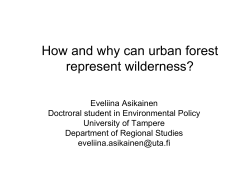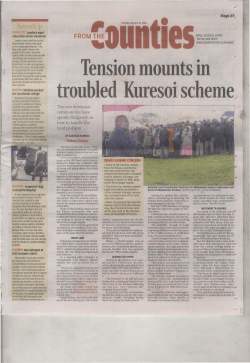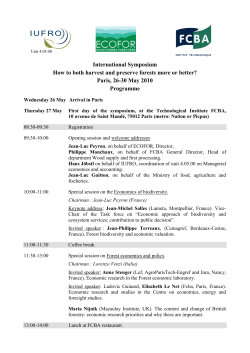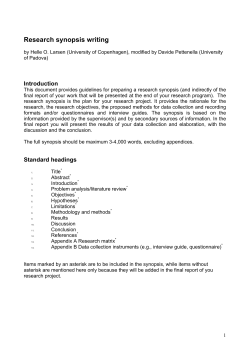
The network of permanent sample plots for forest growth in...
115 The network of permanent sample plots for forest growth in Estonia Maris Hordo, Andres Kiviste and Allan Sims Department of Forest Management, Estonian University of Life Sciences Abstract Both adequate forest stand descriptions and stand growth and structure models are needed for effective and sustainable forest management. The key to successful timber management is a proper understanding of growth processes, and one of the objectives of forest modeling is to provide the tools that enable foresters to compare alternative silvicultural approaches. Models of forest structure and growth are currently being developed in Estonia. Tree-wise re-measured permanent sample plot data are needed to create and maintain forest growth models for Estonia. A new network of permanent sample plots for monitoring the growth and yield of Estonian forests was established in 1995-2005. The network covers the main forest types and the current age distributions of commercial forests in Estonia. The radius of the circular plots ranges between 15 and 30 meters, such that each plot holds a minimum of 100 trees. The sample plots are re-measured at five-year intervals. The polar coordinates and the breast height diameters of all trees are measured. Additionally, the total height, the height to crown base and to the lowest dead branch of 20 percent selected sample trees are measured. Currently, the database of the Estonian network of permanent sample plots contains measurement data for 105 349 trees from 730 sample plots. Altogether 71 506 trees in 492 permanent sample plots have been re-measured once, and 12 841 trees in 97 plots were re-measured two times. A hierarchical system of stand growth models which are compatible with, and based on, distance independent individual tree growth equations appears be most suitable for forest management in Estonia. Consequently, on the basis of re-measurement data, tree growth and mortality were analyzed, and preliminary models have been elaborated. For reliable forest growth modelling, however, data from 3-4 re-measurements (during the next 15-20 years) would be needed. Nevertheless, the currently available data can be used for modelling of forest structure and dynamics, and for pilot studies exploring different methods of data analysis. The new network of permanent sample plots for monitoring the growth and yield of Estonian forests is being used by several scientists. It has already proven its worth as a good data source for testing and building models for sustainable forest management in Estonia. Introduction Models of forest stand growth and structure are the basis for planning forest management activities like cutting, thinning, regeneration etc. Both adequate forest stand descriptions and stand growth and structure models are needed for effective and sustainable forest management. The key to successful timber management is a proper understanding of growth processes, and one of the objectives of forest modeling is to provide the tools that enable foresters to compare alternative silvicultural approaches (GADOW AND HUI 1999). Models of forest structure and growth are currently being developed in Estonia. At the Estonian State Forest Management Centre, a computer based decision support system is being developed. Unfortunately, forest models used in the system should be improved (NILSON 1999). According to forestry literature from last decades (HÄGGLUND 1981, SÖDENBERG 1986, NABUURS AND PÄIVINEN 1996, HYNYNEN ET AL. 2002, PRETZCH ET AL. 2002), traditional growth and yield tables and equations approximating them are being replaced with more sophisticated stand growth simulators. The stand growth simulators based on individual tree growth models used in the Finnish MELA (HYNYNEN ET AL. 2002), the Swedish HUGIN (HÄGGLUND 1981), the Austrian PrognAus (LEDERMANN 2006) and MOSES (HASENAUER ET AL. 2006), the German BWINPro (NAGEL AND SCHMIDT 2006) and SILVA (PRETZSCH ET AL. 2006) would be acceptable types of growth model in a computer-based decision support system. However, much effort is required to establish and maintain long-term observations on permanent forest growth plots. According to results form Finland (HYNUNEN ET AL. 2002), data from at least 3-4 plot re-measurements (over 1520 years) is required for reliable forest growth modelling. This period should be long enough to smooth out annual climate fluctuations. Since today, in Estonia has been established several data sources, what has been used for forest growth and yield modelling: temporary plot data, stem analysis data, traditional forest inventory data, permanent research plot data, national Forest Inventory (NFI) data and new network of forest growth permanent plots (KIVISTE 1999). A growth model enables reasonable predictions to be made about tree growth and stand development. This purpose may be achieved in different ways, depending on the priorities of the user (GADOW 1996). For establishing the network of permanent sample plots, the Finnish permanent sample plot system INKA (Inventory growth plots), TINKA (Young forest inventory growth plots) and SINKA (Inventory growth plots on peatlands) (HYNYNEN 2001) were used. According the methodology, these were regarded as the most representative material available for modelling purposes. DVFFA – Sektion Ertragskunde, Jahrestagung 2006 116 A growth model is a synthesis of dynamic inventory data indicating growth and change in the forest. These data may be obtained from permanent plots. Permanent plots established to provide data for growth modelling should be designed to satisfy this primary need, and should not be compromised in order to satisfy secondary needs. They to not need to provide resource inventory data efficiently, as alternative sampling procedures can fulfill that need (VANCLAY 1994). The disadvantages are, at first that it takes years to get representative data set (problems with financing, disturbances on plots, changes in methodology and field-teams) and secondly additional time cost to determine the location of sample plots. An all-Estonian network of permanent forest growth plots has been designed after a similar Finnish system (GUSTAVSEN ET AL. 1988) to provide empirical data for the models. The measurements of permanent sample plots with tree coordinates were started by U. Peterson in 1995. By now, 730 permanent sample plots have been measured. This paper presents the methods used on and the status in 2005 of the network of permanent sample plots. Method Growth modellers need data to develop models, to test models, and to use models, and each of these tree activities may require data of a different nature. One of the main principles in collecting data for growth modelling is to sample the full range of site and stand conditions, so that model predictions may be interpolated rather than extrapolated (at least in the sense of stand conditions etc) (VANCLAY 1994). A method for establishing a network of permanent forest growth plots was developed at the Department of Forest Management of the Estonian Agricultural University. The following principles were used for designing the network of permanent forest growth plots (KIVISTE AND HORDO 2002, 2003). •A long series of re-measured permanent plots would provide the best data for the modelling of forest stand growth. •All basic forest types and age and density classes should be represented throughout Estonia. •The plots should be randomly placed. •In addition to measurements of trees, tree coordinates on the plots should be determined in order to find the same trees at the next re-measuring and to enable the construction of both distance-independent and distance-dependent models. •Forest growth plots should be large enough to clearly characterize stand regularities. •The network of permanent sample plots should be connected as much as possible with the European forestmonitoring program ICP FOREST I, with the network of National Forest Inventory and with previous research areas for the effective and multiple use of the measurement data. The method of establishing permanent forest growth plots is mainly based on the experience of the Finnish Forest Research Institute (GUSTAVSEN ET AL. 1988). Some recommendations were taken into consideration from Curtis (1983). The codes of species, site types, faults and measurement units were taken from the Estonian NFI instructions (STATISTILISE ... 1999). The following procedures characterize the method. •The compartments for plots were selected before the beginning of fieldwork according to the desired plot distribution (Table 1). For the placement of plot regions, the grid of the European forest-monitoring program ICP FOREST I (KAROLES ET AL. 2000) was used. Also, the grid of the Estonian National Forest Inventory was used to position plot centres. To save on transport costs, 2 or 3 pairs of surveyors worked together establishing several plots in the same plot region. •All trees were measured on circular plots with a radius of 15, 20, 25 or 30 meters (Figure 1) to get at least 100 first-storey trees. Smaller trees (second-storey and under-storey trees) were measured in an inner circle with a radius of 8 (the outer circle 15 m) or 10 (the outer circle more than 15 m) meters. •Measurements on plots were carried out by pairs of researchers. The recorder at the plot centre measured the azimuth and the measurer measured the distance from the plot centre, the breast height diameter in two directions and the faults of each tree. The measured trees were marked with a coloured spot at a height of 1.3 meters. Every fifth tree, dominant trees, trees of rare species and trees in the inner circle were measured as sample trees. For sample trees, the total height, the crown height and the height of dead branches were also measured. Crown height was defined as the height of the lowest live contiguous whorl. In addition to living trees, the coordinates and diameters of standing dead trees and fresh stumps were measured. •The main instruments for tree measurements were a compass, a calliper and a hypsometer “Forester Vertex”. •The age of stand components was determined by counting tree rings from cores extracted from sample trees. The thickness of the soil organic layer was measured in several locations on the plot. •A metal or plastic stick was used to mark the plot centre. In addition, a couple of trees near the plot centre were marked with a coloured circle for easier location in 5 years’ time. The geographical coordinates of plot centres were determined using a GPS device. The plots and their neighbouring objects (roads, ditches, rocks, etc.) were mapped. DVFFA – Sektion Ertragskunde, Jahrestagung 2006 117 Figure 1: Map of trees: MA-Pinus sylvestris, KU-Picea abies, KS-Betula pendula, HB-Populus tremula, LV-Alnus incana, LM-Alnus glutinosa, JT-other tree species. Label of the layers: º 1st storey, ▫ 2nd storey, ▵ aftergrowth, ◊ undergroth, ∗ dead trees, + stubs, - stumps The network of permanent sample plots In Estonia, the first permanent forest growth plots, with tree coordinates, were established by Urmas Peterson in the Pikknurme and Aakre forest districts (Central Estonia) in 1995-1996. In 1997-1998, plots of the same type were established in the Sagadi forest district (North Estonia) and in several areas of south Estonia. During those years, various instruments and methods were tried. As a result, an optimal fieldwork technique was developed. In 1999, a network of permanent forest growth plots to cover the whole of Estonia was designed. From 1999 to 2005, about 100 permanent sample plots were established each year. Figure 2 show that the plots cover most of Estonia. Figure 2: The network of permanent forest growth plots in Estonia established in 1995-2005. Each circle on the map represents a group of plots Figure 2 shows heterogeneous placement of groups of plots. Most plots are placed according to the regular grid of the European forest-monitoring program ICP FOREST I. The frequent groups of plots in north and central Estonia also indicate previously established research areas. DVFFA – Sektion Ertragskunde, Jahrestagung 2006 118 Table 1: Distribution of permanent sample plots by the main forest site types Forest site type Planned plots Established plots 8 Alvar 13 47 Heath 8 292 Mesotrophic 159 135 Meso-euthrophic 99 127 Nemoral 81 58 Herb-rich mixed 111 8 Dwarf-shrub-sphagnum 12 7 Grass fen 17 13 Bog moss 24 35 Full drained swamp 49 Total 573 730 The sample plots are re-measured at five-year intervals. At present, 730 permanent sample plots are established, 492 of which are already re-measured once and 97 plots two times (Table 1Figure 3). Figure 4 show that most of permanent sample plots are established in pine stands. Pine (Pinus sylvestris), spruce (Picea abies) and birch (Betula pendula) are most common and economically important tree species in Estonia. 400 No of sample plots 1s t m eas ure 350 2nd m eas ure 300 3rd m eas ure 250 200 150 100 50 0 Aspen Birch Spruce Pine Other Figure 3: Distribution of permanent sample plots by dominant tree species and measurements Total of 101 374 live trees are recorded at the first measurement, 33 058 of those are sample trees. At the second measure total of 61 361 live trees are recorded, 21 278 of those are sample trees and at the third measure total of 10 224 live trees are recorded, 3 465 of those are sample tree. Total of 189 696 measurement records, including dead trees, are at the current database. At present, Figure 4 show that most common tree species (pine, spruce and birch) in all age classes are represented almost more or less. 160 Others No of sample plots 140 Spruce 120 Birch 100 Aspen Pine 80 60 40 20 0 10 20 30 40 50 60 70 80 90 100 110 120 Age class Figure 4: Distribution of permanent sample plots by age classes and dominant species Data anaysis The network of permanent sample plots data analysis purpose is to develop, to test stand growth models based on individual tree growth and mortality equations for sustainable forest management in Estonia. At the moment there DVFFA – Sektion Ertragskunde, Jahrestagung 2006 119 is a drawback, for reliable forest growth modeling, data from 3-4 re-measurements (during 15-20 years) would be needed. Nevertheless, collected data can be used for modelling of forest structure and for pilot studies in growth data analysis, for example 1) diameter distribution models, 2) diameter and height relationships (KIVISTE ET AL. 2003), 3) crown models, 4) competition indices, 5) spatial structure of trees, 6) individual-trees and stand diameter and height growth models, 7) survival (mortality) probability models (KIVISTE ET AL. 2005), 8) permanent sample plots GIS (Geographical Information System) (LANG ET AL. 2006), and 9) measurement errors / outliers study (HORDO 2004; HORDO 2005; HORDO ET AL. 2005); 10) developing information system for forest management models and datasets (SIMS 2003, SIMS 2004, SIMS ET AL. 2005). Routine inspection of forest plot measurement data for outliers was necessary because it provided information about the causes and consequences of measurement errors. For the detection of outliers, several statistical methods were tested. Empirical distributions of most tree variables by species and storey were analyzed using Grubb’s test, Dixon’s test and the 4-sigma region method. Multivariate methods (height curves, residual diagnostics, logistic regression) were used for detecting outliers in the interaction of several variables. A Visual FoxPro program was elaborated for detecting measurement errors and outliers in the forest sample plot data. The program can be easily adapted for all types of forest sample plot data collected in different ways. Additional re-measurement data will give a chance to update the statistical criteria and models used in the program and make it more sensitive (HORDO 2004). Scientific activity as a whole is somehow related to creating, applying or checking models. In a forestry information system it is now possible to use information on forestry in the form of models. The aim of the database of forest management models is to standardize the form of forest management models and to simplify working with them in application software. The database contains 12 tables. There are tables for formulas, constants, authors, papers, variables, etc. The application allows the testing of models. There are two different ways to test, one where a user can give some values to arguments and the results are drawn as a chart, and another where the results are calculated based on test data. The first one can be used with all models. It is the initial test to see if model constants and arguments are entered correctly. The second type of test is where results are calculated into a table using the test data. The database currently includes 181 forest measurement models from 10 countries. The database is web-based and freely available at http://www.eau.ee/~mbaas/ (SIMS ET AL. 2005). At present, model for survival (mortality) probability were developed. Tree survival (mortality) probability depending on tree and stand variables have studied. For modeling of tree survival probability, a logistic model using the logit-transformation was applied. Tree relative height had the utmost effect to tree survival probability. However, different factors were included into the logistic model for stands at different development stages: tree height, stand height and site index for young and pole stands; tree relative height, relative basal area of larger trees and stand density for middle-aged and maturing stands; tree relative height and stand density for mature and overmature stands. Acquired results improve our understanding about tree and stand dynamics in Estonian forests. The models can be used as preliminary sub-components for elaboration of the individual tree based stand growth simulator (KIVISTE ET AL. 2005). The study of individual tree growth models has started. Diameter growth was calculated from basal area increment. Several age-dependent growth models were studied. The expected growth for a given five-year period under average conditions was predicted using individual tree models developed by Clutter and Jones (FORSS ET AL. 1996). This age-dependent growth models has been used with good success, it involves a function which estimates the change in relative tree size. And the beauty of using relative basal area model lies in the fact that stand-based projection and individual tree-based projection can be made compatible. The method has been used successfully in even-aged forest with various tree species (GADOW 1996) and on the permanent sample plot data in Estonia. Conclusions Tree-wise re-measured permanent sample plot data are needed to create and maintain forest growth models for Estonia. A new network of permanent sample plots for monitoring the growth and yield of Estonian forests was established in 1995-2005. The network covers the main forest types and the current age distributions of commercial forests in Estonia. Data from repeatedly measured long-term growth and yield permanent sample plots provide enough variation in growth factors (e.g. stand densities) in order to study the growth patterns of stands and trees growing in different conditions. The plot size is large enough for modelling stand dynamics, and data are geographically quite representative. Currently, the database of the Estonian network of permanent sample plots contains measurement data for 105 349 trees from 730 sample plots. Altogether 71 506 trees in 492 permanent sample plots have been re-measured once, and 12 841 trees in 97 plots were re-measured two times. Network of forest growth plots is a good data-generator for testing and building models for sustainable forest management in Estonia. First models for individual-tree growth and mortality have developed. Nonlinear models with models with limited number of parameters and ’logical forms’ could be preferred in growth studies. Additional forest growth models of neighboring countries should be tested on Estonian permanent data. A database of forest management models is under construction for including varieties of different forest models in Estonia and neighboring countries (http://www.eau.ee/~mbaas/). The information system is expected to become a DVFFA – Sektion Ertragskunde, Jahrestagung 2006 120 useful tool for modelers as well as end-users of models. As the number of models in the system is not limited, new models can continually be added into the system (SIMS 2005). The new network of permanent sample plots for monitoring the growth and yield of Estonian forests is being used by several scientists. It has already proven its worth as a good data source for testing and building models for sustainable forest management in Estonia. Acknowledgements The establishment of the network of permanent forest growth plots was supported by the Estonian Science Foundation (Grants No 2617, 4813 and 5768), the Estonian State Forest Management Centre and the Centre of Environmental Investments. References CURTIS, R.O.: Procedures for establishing and maintaining permanent plots for silvicultural and yield research. USDA Forest Service General Technical Report PNW-155. Portland, OR, 56 p., 1983 GADOW, v. K., HUI, G.: Modelling Forest Development. Kluwer Academic Publishers. London, 213 p., 1999 GADOW, v. K.: Modelling growth in managed forests – realism and limits of lumping. The Science of the Total Environment, 183: 167-177, 1996 GUSTAVSEN, H. G., ROIKO-JOKELA, P., VARMOLA, M.: Kivennäismaiden talousmetsien pysyvät (INKA ja TINKA) kokeet. Metsäntutkimuslaitoksen Tiedonantoja, 292. Helsinki: 212p., 1988 HÄGGLUND, B.: Forecasting growth and yield in established forests. An outline and analysis of the outcome of subprogram within the HUGIN project. Swedish University of Agricultural Sciences, Report 31. Umeå, 145 p., 1981 HASENAUER, H., KINDERMANN, G., STEINMETZ, P.: The Tree Growth Model MOSES 3.0. In Hasenauer, H. (Ed.) Sustainable Forest Management, Growth Models For Europe, Springer, Berlin, Heidelberg. 64-70, 2006 HORDO, M., KIVISTE, A., SIMS, A., LANG, M.: Outliers and/or measurement errors on the permanent sample plot data. IUFRO conference proceedings: Sustainable forestry in theory and practice. Submitted. 2005 HORDO, M.: Erindite diagnostika puistu kasvukäigu püsiproovitükkide andmestikul / Outliers diagnostics on permanent sample plot network. M.Sc. Thesis. Tartu, 137p., 2004 HORDO, M.: Erindite ja / või mõõtmisvigade avastamise meetoditest puistu kasvukäigu püsiproovitükkide andmestikul. Metsanduslikud uurimused 43, Tartu: 9-23, 2005 HYNYNEN, J., OJANSUU, R., HÖKKA, H., SIIPILEHTO, J., SALMINEN, H. and HAAPALA, P.: Models for predicting stand development in MELA system. The Finnish Forest Research Institute. Research Papers, 835. Vantaa Research Center, 116 p., 2002 HYNYNEN, J.: Application of Data from Permanent Experiments and Forest Inventories in the Development of Growht Models Applied in Forest Management Planning. Modelling Volume, Growth and Mortality. Nordic Trends in Forest Inventory, Management Planning and Modelling – Proceedings of 2001 SNS Meeting: 195196, 2001 KAROLES, K., ÕUNAP, H., PILT, E., TERASMAA, T., KIVITS, H.: Forest conditions in Estonia 1988-99, defolation and forest damages on Level I sample points. – Air pollution and forest in industrial areas of north-east Estonia. Forestry Studies XXXIII, Tallinn: 209-216, 2000 KIVISTE, A., AJAOTS, J., HORDO, M., SIMS, A.: Puude väljalangevust mõjutavad faktorid puistu kasvukäigu püsiproovitükkide andmete põhjal. Metsanduslikud Uurimused 43, Tartu: 132-158, 2005 KIVISTE, A., HORDO, M.: Eesti metsa kasvukäigu püsiproovitükkide võrgustik. Metsanduslikud uurimused XXXVII, Tartu: 43-58, 2002 KIVISTE, A., HORDO, M.: The network of permanent sample plots for forest growth modelling in Estonia. Scientific Conference Proceedings ‘Research for Rural Development 2004’, Latvian Agricultural University, Jelgava: 174-177, 2003 KIVISTE, A., NILSON, A., HORDO, M., MERENÄKK, M.: Diameter distribution models and height-diameter equations for Estonian forest. Modelling Forest Systems / edited by Amario, A., Reed, D., Soares, P. CABI Publishing, 169-179, 2003 KIVISTE, A.: Eesti puistute kasvumudelitest. EPMÜ metsandusteaduskonna toimetised nr. 32, Tartu: 28-36, 1999 LANG, M., NILSON, T., KUUSK, A., KIVISTE, A., HORDO, M.: The performance of foliage mass and crown radius models in forming the input of a forest reflectance model: A test on forest growth sample plots and Landsat 7 ETM+ images. Submitted to Elsevier Science. 42p., 2006 LEDERMANN, T.: Description of PrognAus for Windows 2.2. In Hasenauer, H. (Ed.) Sustainable Forest Management, Growth Models For Europe, Springer, Berlin, Heidelberg. 71-78, 2006 NABUURS, G.J. and PÄIVINEN, R.: Large scale forestry scenario models – a compilation and review. European Forest Institute. Working Paper 10. Joensuu, 174 p., 1996 NAGEL, J., SCHMIDT, M.:The Silvicultural Decision Support System BWINPro. In Hasenauer, H. (Ed.) Sustainable Forest Management, Growth Models For Europe, Springer, Berlin, Heidelberg. 59-63, 2006 DVFFA – Sektion Ertragskunde, Jahrestagung 2006 121 NILSON, A.: Pidev metsakorraldus – mis see on. Pidev metsakorraldus. EPMÜ Metsandusteaduskonna toimetised nr. 32, Tartu, 4-13, 1999 PRETZSCH, H., BIBER, P., DURSKY, J.: The single tree-based stand simulator SILVA: construction, application and evaluation. Forest Ecology and Management 162, 3-21., 2002 PRETZSCH, H., BIBER, P., ЇURSKÝ, J., SODTKE, R.: The Individual-Tree Based Stand Simulator SILVA. In Hasenauer, H. (Ed.) Sustainable Forest Management, Growth Models For Europe, Springer, Berlin, Heidelberg. 78-84, 2006 SIMS, A., KIVISTE, A., NILSON, A., HORDO, M.: An Information System for Forest Management Models and Datasets. IUFRO conference proceedings: Sustainable forestry in theory and practice. Submitted. 2005 SIMS, A.: Metsanduslike mudelite andmebaas, Master’s thesis, Estonian Agricultural University. Tartu: 217p., 2003 SIMS, A.: Online database of forestry models. International Scientific Conference Proceedings ‘Research for Rural Development 2004’, Latvian Agricultural University, Jelgava: 178-180, 2004 SIMS, A.: Takseermudelite andmebaasi loomisest / The database of forest management models. Metsanduslikud Uurimused 43, 124-131, 2005 SÖDERBERG, U.: Funktioner för skogliga produktionsprognoser. Tillväxt och formhöjd för enskilda träd av inhemska trädslag i Sverige. Sveriges lantsbrukuniversitet, Rapport 14. Umeå, 251 p., 1986 STATISTILISE METSAINVENTEERIMISE VÄLITÖÖDE JUHEND.: [National Forest Inventory field works instructions] (In Estonian.) Eesti Metsakorralduskeskus. Tallinn, 55 p., 1996 VANCLAY, J. K.: Modelling Forest Growth and Yield. Applications to Mixed Tropical Forests. Copenhagen, 329p., 1994 Maris Hordo, Andres Kiviste and Allan Sims; Department of Forest Management, Estonian University of Life Sciences; Kreutzwaldi 5, 51014 Tartu, Estonia, maris.hordo@emu.ee DVFFA – Sektion Ertragskunde, Jahrestagung 2006
© Copyright 2025









